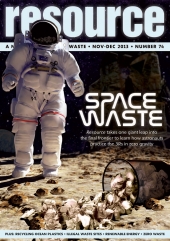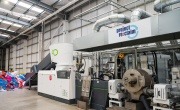Getting from A to B
The recycling industry now uses all sorts of exciting sorting technology, making it easy to forget about the humble conveyor belt. But, as Will Simpson learns, we’d be paralysed without them

It’s not an exaggeration to say that without them, the recycling industry would come to a standstill. Conveyors, those humble transporters that carry material of all shapes, sizes and levels of recyclability from A to B, are often forgotten about but are absolutely crucial. Think about it – how on earth would a material recovery facility (MRF) or reprocessor operate without them? Would material have to be carried about by hand? Or on a toy train set?
These days, they come in an array of styles that can be succinctly summed up as three essential types: idler conveyors, slide bed conveyors and chain belt conveyors. The chain belts, as you would expect, transport material along a belt that is attached to a chain that runs round a tail shaft – they can be elevated or move material up and down a slope. With idler conveyors, the belt – rather than the chains – is carried along a series of rollers, whereas with slider bed conveyors, the rollers are replaced by a metal bed, along which the material slides.
Needless to say, the waste and recycling industries make good use of all of them. MRF operator Casepak is typical in that it has some of each. “We use elevated chain belt conveyors for when we want to transfer recyclables or finished product from ground level up to our full cabin”, explains Director of MRF Operations Kevin Thomas. “It’s the one that is probably more unique to the recycling industry in some senses – the one thing that we have to do is get material from the ground level up to a height to present it to screens and sorting and so on.
“We also have an idler conveyor, which is for when we want to transport material over a longer distance – usually more abrasive material like glass or end-of-process residues. And we do have one slider bed conveyor. They tend to be used for short lengths – you tend to find those in more distribution-y type places.”
Meanwhile, plastics reprocessor Closed Loop Recycling uses just elevated chain belt conveyors at its plant in Dagenham. “Our conveyor system looks like something Heath Robinson would come up with on a good day”, explains Marketing Manager Nick Cliffe. “We have conveyors that go all over everywhere – because we’re quite crammed into a small space we have to go multilevel. We’ve added extra conveyors as we’ve gone along and we maintain an element of configurability, but some of our conveyors are quite big, thick pieces of equipment – they haven’t moved since the day they were first installed.”
For all the three main types, costs vary, as do their lifetime. Belts usually end up having to be replaced at least once every five years, but, if well maintained, a conveyor itself can last up to 15 years. That, of course, depends on wear and tear, which in turn depends on the type of material it transports and the sort of servicing it gets. “The service requirements for ours are just making sure that the chain is oiled”, says Chris Deacon, Sales Manager of chain belt conveyor manufacturer BOA Recycling Equipment. “If they are feeding a baler, there would be a conveyor pit and you just have to make sure that you clean the conveyor pit out regularly – they are susceptible to collecting water, which will rust them, of course. Generally, though, they are pretty durable. You can put large amounts onto the belt without it having an adverse effect.”

The main operation considerations for all three types tend to be the same: the length over which you’re transporting the material and the nature of the material you’re putting on it. How heavy is it? How abrasive is it? Is it aggressive material or more inert? “The materials dictate everything”, says Roy Miller, MRF designer at Oregon-based Bulk Handling Systems. “The size of the conveyor is driven by both the bulk density of the material and the size of the material. Some material in a MRF can have a really low bulk density but a very large size – newspaper being a classic example. In that case, you still have to have a conveyor with large volumetric capacity.
“The material will also dictate whether you have to have an extra heavy conveyor. If you’re transporting construction and demolition debris, it’s not unusual to have 100-150 kilogramme pieces of stone or concrete, so in those cases you’ll have a heavy conveyor chassis design especially in the loading area, to accommodate the large sizes of material. But if all you’re handling is baled plastic containers, you’re going to have a much lighter-weight chassis.”
The design of the conveyor itself hasn’t changed that much over the recent years – essentially, it’s still the same powered belt it’s always been. The significant changes have occurred in the ancillary elements that make up a conveyor system. Bill Martin is Technical Support Manager at Smiley Monroe, a Northern Irish firm that manufactures belts and ancillary products for conveyors: “The big advancements in the last 20 years have been on the electronic side of things. In the 1990s, for example, if there was a quarry you knew if you had enough stone crushed when the stockpile was X number of feet high. Now, with electronic weighers, it can be measured. Every second you will know what the output of your machine is going up that conveyor. The accuracy that the electronic side of things that brought has been a big improvement.
“The other big leap forward has been the material the conveyor belts are made from, so that they are able to withstand high temperatures and specialist acids. In the recycling industry, because of the way that has changed, we’re now often asked to supply belts that are oil, acid and fat-resistant all in one go.”
 This article was taken from Issue 74
This article was taken from Issue 74Looking to the future, Miller suggests we’ll see improvements in conveyor systems’ efficiencies. “Probably, we’ll be able to understand what is happening in such detail that you can calculate the power requirements for the conveyors to a very exacting high standard. The waste processing industry is interesting in that material can be dry during the summer and wet in the winter and therefore the tonnes per hour moving through the system can vary just by the fact that you’re carrying additional water.
“The equipment ages and maintenance vary between different operators, and so as an equipment supplier, you tend to compensate for that in sizing the motors for the conveyors, which means you may have more horse power than you need for most of the year, but there may be moments when you need that extra capacity. As everyone is concerned about their energy consumption, what I see going forward is the necessity to be able to predict more closely what the actual power requirements are, and maybe finding creative ways to provide additional power when you need it.”
Whichever way it develops, it seems certain that the conveyor will remain a (moving) fixture in the recycling industry for some time to come. “We’ve got all sorts of exciting machinery”, adds Cliffe. “Optical sorters...manual sorters...eddy current separators...you almost don’t notice the conveyors, particularly if they’re doing their job properly. But they’re absolutely pivotal. They’re unglamorous but absolutely essential. And if they’re not running smoothly, you really are paralysed.”





